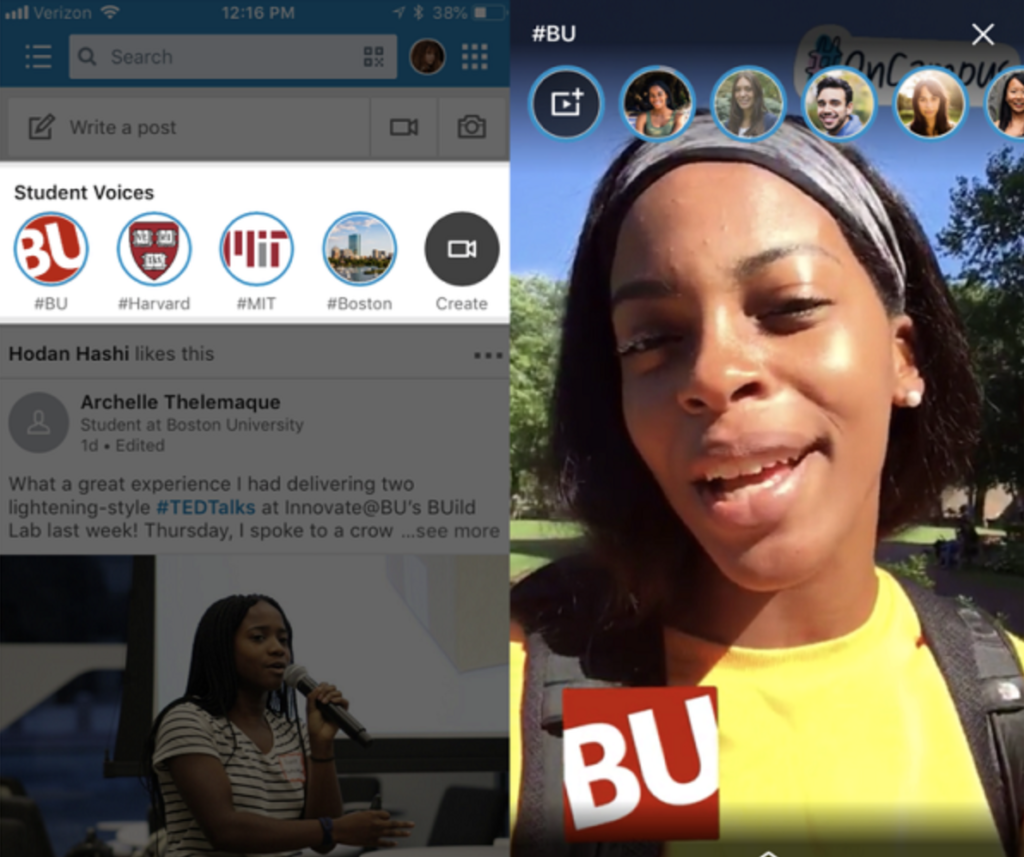While LinkedIn is mostly seen as a digital resume and networking tool, that doesn’t mean the social network isn’t building itself to be as engaging as possible. That’s why it should come as no surprise that LinkedIn is currently testing and will soon be launching a “Stories,” following in the footsteps of Snapchat, Instagram, and Facebook.
Last month, LinkedIn’s Senior Director of Product Management Pete Davies explained:
We’re never done meeting our members where their voices are. Last year, we started asking ourselves what Stories might look like in a professional context. Stories first appeared on Snapchat, with other platforms like Instagram and Facebook adopting them soon after. They spread for a good reason: they offer a lightweight, fun way to share an update without it having to be perfect or attached to your profile forever.
So while Stories may seem like an odd fit for LinkedIn, within that context, they make perfect sense. Not all business communication is so formal and buttoned up. Think about your conversations with co-workers. Sure, you talk about ongoing tasks and upcoming projects, but you also make jokes and have light-hearted conversations (I hope). Why shouldn’t that extend outside the office and across your digital network too?
In 2018 LinkedIn launched “Student Voices,” so this also isn’t their first foray into non-permanent posts. However, “Student Voices” was pretty limited. For one, it was only available to university students in the US, and second, posts were restricted to using video only.
Given what we know about how this feature works on other social networks, let’s take a look at the impact it could have on LinkedIn.

Image Source Social Media Today
Product Details
Like many new social media features, LinkedIn has tested the rollout of Stories in a few markets – Brazil, Netherlands, UAE, and, most recently, Australia – and they seem to be adding a new market or two every few weeks. Given the pace of use and feedback collection, it’s likely only a matter of time before Stories are released globally.
The Story posts themselves are what you’d expect and have seen on other platforms. Users take a photo or video (up to 20 seconds), add text or stickers, then publish where your connections and followers can view it for 24 hours.
However, LinkedIn still enables its existing privacy settings. Similar to how LinkedIn offers users the choice of whether or not they want others to know they viewed their profile, LinkedIn provides that same choice on Stories. So when you view a Story, the creator will either see 1) your name and headline, 2) your profile characteristics (ex. title and/or company), or 3) anonymous (private mode).
What Kind of Impact Will LinkedIn Stories Have?
1. Makes the Platform More Approachable/Less Intimidating
All things considered, posting on Facebook or Instagram is pretty safe. Especially with their security features, you can ensure that only your friends and family see the content you post. However, LinkedIn is a bit more intimidating. Your connections there aren’t necessarily your social circle, they’re co-workers, bosses, potential employers – the exact people you made your other social networks private to hide from! Of LinkedIn’s 310 million monthly active users, only 3 million share content on a weekly basis. That’s less than 1%!
Stories allow people a safer way to dip their toe in the water and start engaging on the platform. Knowing the post will only be live for 24 hours (at most), users can feel more secure in testing things to post, then seeing how they feel about it or what kind of reaction it gets.
2. Can Increase Engagement & Networking
An Instagram post may generate many likes, but comments are often pretty generic. It’s not often you see anything resembling in-depth discussion, because as social media use has evolved, people prefer to keep conversations more private. Stories allow that sort of more private engagement to a public post. Now, Instagram might be more of a place to “slide into DMs,” but LinkedIn can provide a similar space for a more private conversation.
Maybe an industry thought-leader makes a forecast on trends in your specific line of work – what better place to ask them a question that they might actually answer? Perhaps a C-Level executive posts about your company’s future – responding via LinkedIn Story gives you a chance to engage with them one-on-one. Maybe you see a friend or former co-worker post about how much she loves her current job – LinkedIn stories gives you a chance to ask about the company culture (and if they’re hiring).
3. New Medium For Ad Products
As marketers who specialize in B2B and SaaS, we’d be remiss if we didn’t see this as an opportunity to promote our client’s products (and even ourselves). While it’s not an apples-to-apples comparison, looking at the success of Instagram Stories gives us some benchmarks.
62% of people who use stories across the Facebook family of apps surveyed said they have become more interested in a brand or product after seeing it in stories. With LinkedIn’s 1st party data, smart marketers can ensure that their products are getting in front of the decision-makers whom they most highly covet.
The introduction of Stories also opens the door for the rise of the LinkedIn influencer. Many professionals are already using LinkedIn to promote themselves as thought leaders, but it’s not a very engaging platform for products. Stories could open up opportunities to more seamlessly integrate products. Whether or not this is a good thing is up for debate, but the possibility is certainly there.
How to Use LinkedIn Stories?
1. “Live” Broadcasts from Events
While events themselves can be a great way to reach new people and customers, their downside is that they’re generally high effort and time, but low reach. LinkedIn Stories could be a great outlet to get some extra reach for your efforts.
If your company has a booth at a convention, let people know you’re there and where they can find you. If your founder or other high-level executive is giving a keynote at a conference, stream some of the highlights to extend your thought leadership.
2. Host Q&As
Livestreamed Q&As have become a popular form of content across a number of platforms, but haven’t really worked their way into the business world quite yet. LinkedIn Stories could be the first platform that opens up real-time communication with prospective customers or other industry professionals.
As a result of the Coronavirus quarantine and subsequent business downturn, we at NoGood wanted to help where we could, so we created a Growth Helpline where SMBs can schedule free strategy sessions with our team. We’ve been scheduling calls with business owners to answer questions and offer advice on how to weather the storm and get your business back on track. With LinkedIn Stories, we could have scheduled this as a live event, where we could answer more common questions and give more general advice, allowing us to help even more people.
3. Share Brand Announcements & Product Updates
One of the most impactful growth trends for SaaS companies has been the rise of Feature Marketing, where companies add new features to their products and use those to market to new customers. It’s so effective because it presents opportunities for all touchpoints in the marketing funnel – acquisition, activation, and retention.
LinkedIn Stories could potentially be one of the best ways to leverage this tactic. They could be utilized before building out a new feature, using Stories to get a feel for the demand of it. Stories could be used to tease, then announce the release, driving acquisition and activation. Lastly, stories would give SaaS companies yet another way to continue engaging with their existing customers, leading to improved retention.
4. Another Vehicle To Promote Content
Everyone is always looking for new ways to promote their content, so it’s almost inevitable that brands would try to leverage LinkedIn Stories as well. Where it could differ is the way it’s presented. Brands could create small, snackable bites so that followers can learn something quickly or click through for a deep dive into the full article.
For example, at NoGood, we recently published a piece on the NoGood blog on Growth in the Time of Corona, where we gave ten helpful tips on how to survive the current economic downturn. This content was then re-formatted into what’s essentially a ten slide deck, providing a topline overview of each tip, which we published to the NoGood Instagram. While we’re happy to get the extra reach for it, being able to promote this content across LinkedIn, where it could more easily reach the business professionals we’re hoping to help.
The Takeaway
While the stories feature is often used in fun, nonsensical ways across the likes of Snapchat and Instagram, it’s understandable why it might seem like an odd fit on LinkedIn. However, a deeper dive shows its potential to help both consumers and businesses alike. In the end, it’s hard not to agree with Pete Davis when he says:
I’m excited to see how Stories will bring creativity and authenticity to the ways that members share more of their work life, so that they can build and nurture the relationships necessary to become more productive and successful.
What do you think? Would you use LinkedIn Stories? If so, in what ways do you think would be useful? What features would you like to see included in the final product?
Let us know in the comments!





